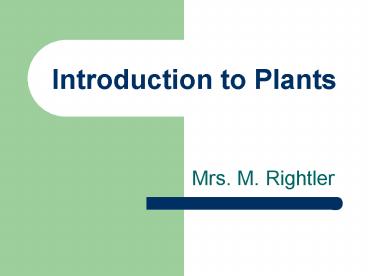Introduction to Plants - PowerPoint PPT Presentation
1 / 28
Title:
Introduction to Plants
Description:
Incomplete flowers = missing one or more parts. Types of Angiosperms [115] Monocots ... Flowers = multiples of 4 or 5. Leaf veins branching. Plant Tropisms ... – PowerPoint PPT presentation
Number of Views:143
Avg rating:3.0/5.0
Title: Introduction to Plants
1
Introduction to Plants
- Mrs. M. Rightler
2
Earliest Plants
- Algae
- Phytoplankton
- Lived in the sea
3
Problems with life on land
- Problem
- Drying Out
- Making Food
- Reproduction
- Gravity Support
- Getting water nutrients
- Solution
- Waxy cuticle, stomata
- Formed leaves
- Develops spores seeds
- Bark (cork) vessels
- Roots vessels
4
Types of Plants
- Avascular
- Bryophytes
- nonseed plants
- Tracheophytes
- vessels for transport and support
5
Mosses Liverworts The Bryophytes
- First land plants
- AVASCULAR very small
- 500 m.y.a.
- Must grow in moist environments
- Used for fuel (peat)
6
Reproduction in Bryophytes
- Mosses have a protonema (liverworts do not)
- Sexual reproduction
- Antheridium makes sperm
- Archaegonium makes eggs
- Asexual reproduction
- Fragmentation
- Formation of gemmae
7
Tracheophytes
- Vessels
- XYLEM transports water dissolved minerals
from roots to leaves - PHLOEM transports sugars from leaves to rest of
plant - Spores or seeds for reproduction
8
Club Mosses (Lycophyta)
- Leaves produce spores
- Strobilus spore-bearing leaves
- Prothallus produces antheridia archaegonia
9
Horsetails (Sphenophyta)
- Jointed stems
- Reproduction similar to club moss
10
Ferns (Pterophyta)
- 400 m.y.a.
- Dominant form sporophyte
- Structure
- Rhizome underground stem
- Fronds leaves
- Sori store spores on underside of fronds
11
Gymnosperms
- Gymno naked Sperm seed
- First plants to produce seeds
- No flowers
- No fruit
12
Why Make Seeds?
- Has own food supply
- Protective coat against harsh conditions
- Some are designed for travel to new areas
13
Sporophytes produce
- MICROSPORE
- Produce male gametophyte
- Produce pollen
- MEGASPORE
- Produce female gametophyte
- Produce ovule (makes archaegonia with egg cells)
14
Gymnosperm Reproduction
- Pollen grains carried by wind
- Land on ovule, develop pollen tube
- Sperm move through tube to fertilize egg
- Fertilized egg ZYGOTE
- EMBRYO young, diploid sporophyte plant
- COTYLEDONS food storage for embryo, become
first leaves
15
Why Pollen Instead of Spores?
- Plant can live in very dry areas
- Fertilization does not require water
- Pollen has protective coat and food supply for
sperm
16
Why Ovules Instead of Archaegonia?
- Protective tissues prevent drying out
- Ovule holds archaegonia and protects eggs from
elements
17
Minor Gymnosperm Groups
- Cycadophyta (1st in Triassic Era)
- Ginkgophyta
- Only one species today Ginkgo biloba
- Most lived 200 m.y.a.
- Gnetophyta only three genera
- Gnetum house plants
- Ephedra weight loss, allergies asthma
- Welwitschia
18
Coniferophyta (largest group)
- Needle or scale-like leaves
- Bear seeds in woody cones
- Can live in very cold climates
- Most are evergreens
- Have wood
- Made of thick-walled vessels (TRACHEIDS)
- Tracheids are xylem
19
Angiosperms
- Angio flower Sperm seed
- Extremely diverse
- All have seeds enclosed in fruit
20
Cambium
- Any growth tissue in plants
- Types of cambium
- Vascular produces xylem phloem
- Cork produces cork (bark)
21
Overall Structures 121
- Roots
- Stems
- Leaves
- Flowers
22
Roots 124
- Absorb water nutrients
- Hold plant in place
- Root types
- Fibrous
- Tap
- Prop
- Aerial
23
Stems 123
- Support leaves flowers
- Sometimes photosynthesis
- Transport (contain xylem phloem)
- Types
- herbaceous green flexible
- Woody stiff, have cork layer, usually brown
24
Leaves 119
- Cuticle protection
- Stomata gas exchange, water loss
(transpiration) - Epidermis protection, color
- Mesophyll
- Palisade most PHOTOSYNTHESIS
- Spongy Vascular bundles run through it
25
Flowers 131
- Pistils female reproductive structures
- Stamens male reproductive structures
- Complete flowers
- Have petals sepals
- Have male and female parts
- Incomplete flowers missing one or more parts
26
Types of Angiosperms 115
- Monocots
- mono one
- cot seed leaf
- Approx. 60,000 species
- Flowers multiples of 3
- Leaf veins parallel
- Dicots
- di two
- cot seed leaf
- Approx. 170,000 species
- Flowers multiples of 4 or 5
- Leaf veins branching
27
Plant Tropisms
- Tropism plant response to external stimulus
- Positive plant moves toward stimulus
- Negative plant moves away from stimulus
- Types
- Phototropism light
- Gravitropism gravity
- Thigmotropism touch
- (nastic movement direction does not matter)
28
Plant Hormones
- Hormone chemical produced in one part of an
organism that has an effect on a different part
of the organism - Types
- Auxins regulate growth
- Gibberellins speeds growth, germination
- Abscisic acid dormancy, close stomata, stress
- Ethylene ripens fruit

